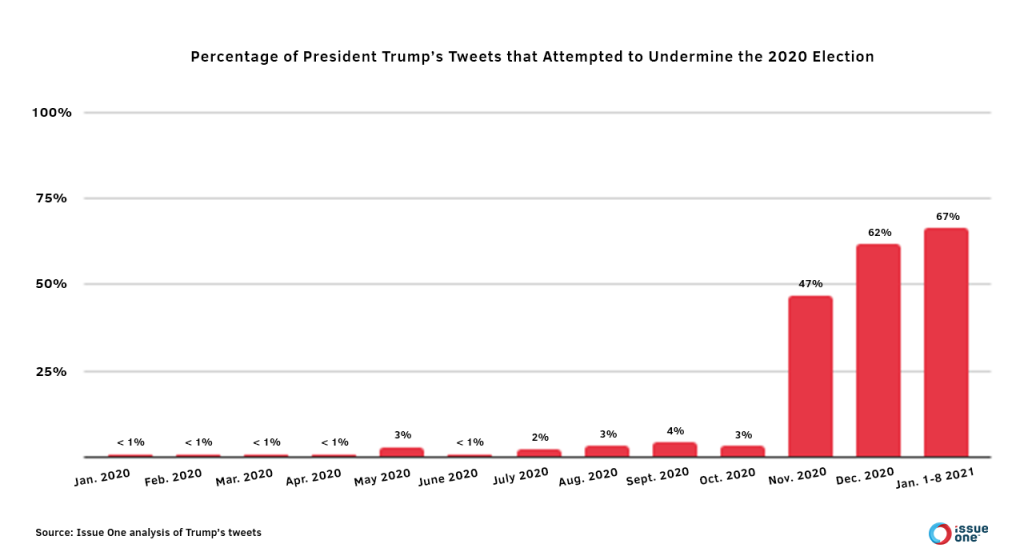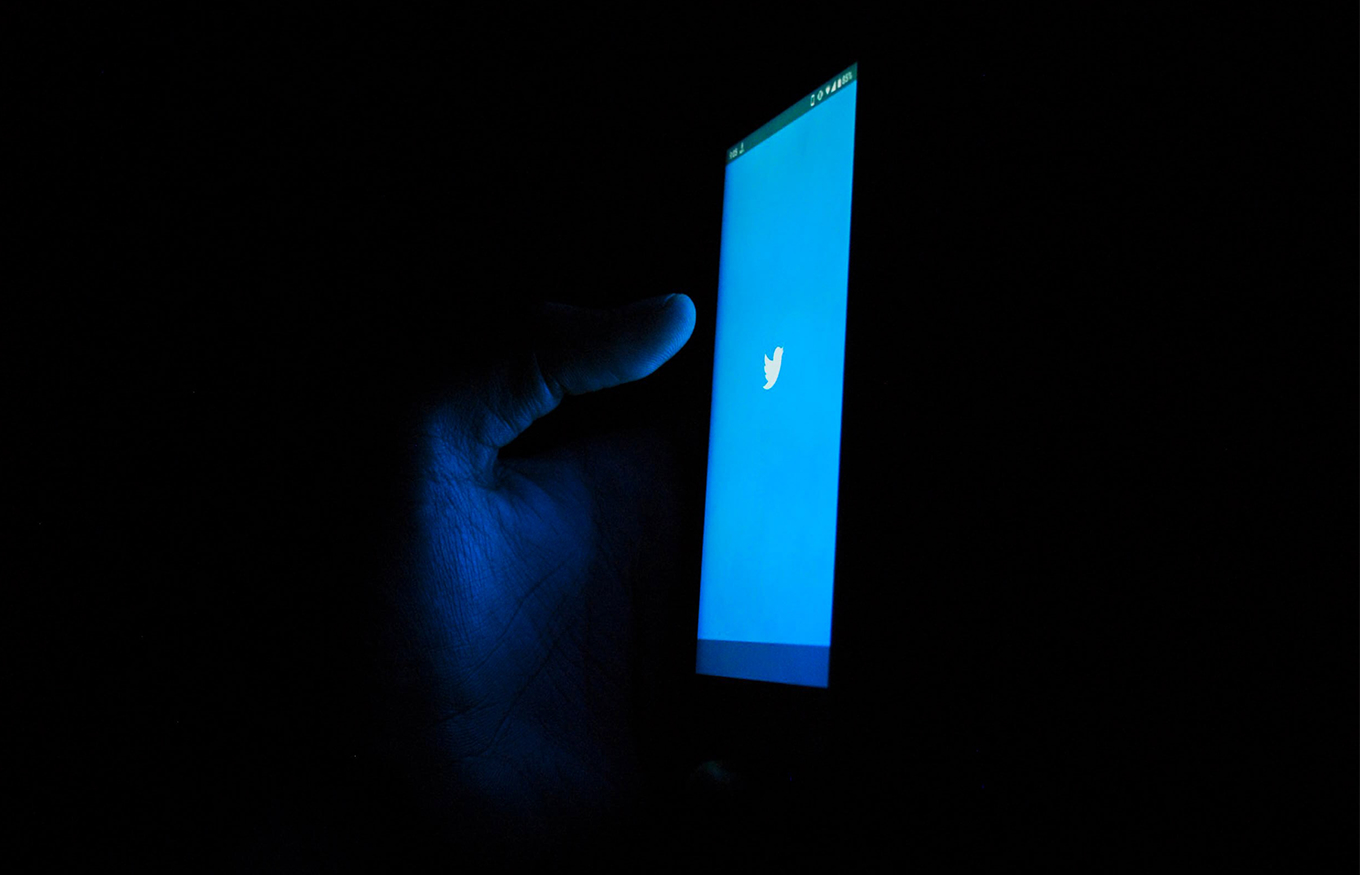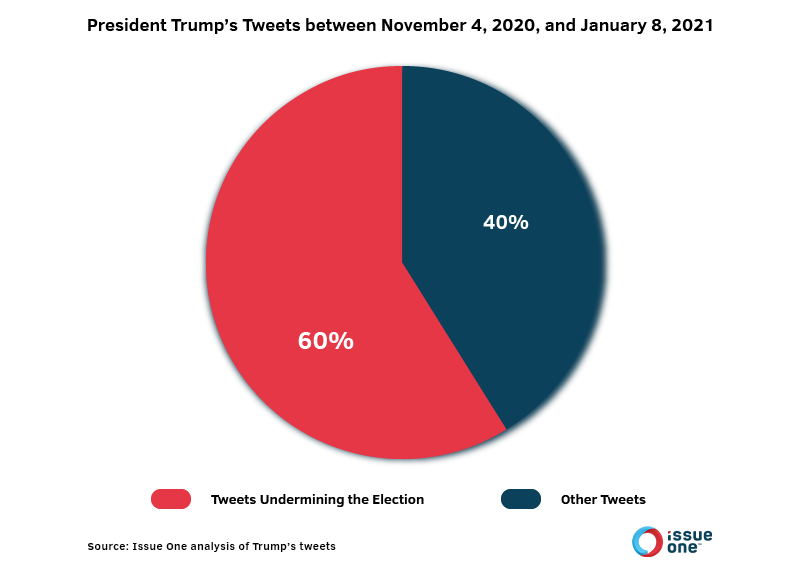Despite record turnout in the 2020 election, the American people’s confidence in our institutions and political system is at a dangerously low level. Against this backdrop, new research from Issue One reveals the extent to which then-President Donald Trump used his Twitter account to undermine the legitimacy of the 2020 election and sow doubts about our democratic processes.
In a new analysis designed to chronicle the spread of dangerous lies and conspiracy theories that eroded voters’ confidence in free and fair elections in 2020, Issue One found that 60% of Trump’s 1,500-plus tweets between the day after Election Day and January 8, when Twitter permanently suspended his account, were messages that sought to challenge the results of the 2020 election — an average of about 14 tweets per day.
“For months before the election and then weeks afterward, then-President Donald Trump systematically utilized his Twitter account to broadcast hundreds of falsehoods about the election with the goal of manufacturing a crisis of confidence and overturning the results of the 2020 presidential election,” said Issue One Founder and CEO Nick Penniman.
Penniman continued: “Social media companies must do more to combat disinformation online, particularly when it comes to America’s elections. Moreover, a healthy democracy requires a commitment to norms that bolster the electorate’s faith in elections, including a willingness to accept electoral defeats and an inclination to participate in peaceful transfers of power.”
Penniman concluded: “It is incumbent upon all of us to fight disinformation about our elections and work to restore people’s trust in our political system. We are all responsible for the success of democracy in America, where voters, not politicians, determine the outcome of free and fair elections.”
Last fall, Issue One’s National Council on Election Integrity — a bipartisan group of more than 40 government, political, and civic leaders — launched a public education campaign to defend the legitimacy of our elections, call for patience from the electorate while ballots were counted, and advocate for more support for state and local election officials.
Issue One’s work to strengthen the administration of elections — and people’s trust in our political system — will continue in 2021 and beyond.
According to a Quinnipiac University poll earlier this month, 7 in 10 Americans think democracy in the United States is “under threat.” And the Economist recently rated the United States as a “flawed democracy” — behind nations including France, South Korea, and Chile — in part because “public trust in the democratic process was dealt a blow by the refusal of Donald Trump and many of his supporters to accept the election result.”
In his post-election tweets, Issue One found that Trump falsely called the election “rigged” 57 times, baselessly alleged that the election was “stolen” or that the Democrats tried to “steal” it 57 times, inaccurately declared that he “won” the presidential election 25 times, and falsely called the outcome a “landslide” victory in his favor 12 times.
Trump’s efforts to undermine the public’s confidence in the election escalated dramatically after the race appeared too close to call on election night. In reality, millions of ballots were still being counted, and Democratic presidential nominee Joe Biden was on his way to winning the critical battleground states of Arizona, Georgia, Michigan, Nevada, Pennsylvania, and Wisconsin.
In many of these states, election officials were dealing with record numbers of absentee ballots, and in some of them — including Pennsylvania and Wisconsin — election officials had been prohibited from processing this deluge of mail-in ballots prior to Election Day, leading to widely predicted delays in the reporting of results, which Trump tried to exploit.
Some examples of the disinformation and conspiracy theories Trump was spreading online in the post-election period include:
- On November 4, 2020, the day after Election Day, Trump tweeted: “We are up BIG, but they are trying to STEAL the Election. We will never let them do it. Votes cannot be cast after the Polls are closed!”
- On November 15, he tweeted: “He only won in the eyes of the FAKE NEWS MEDIA. I concede NOTHING! We have a long way to go. This was a RIGGED ELECTION!”
- On December 12, he tweeted: “I WON THE ELECTION IN A LANDSLIDE, but remember, I only think in terms of legal votes, not all of the fake voters and fraud that miraculously floated in from everywhere! What a disgrace!”
- On December 22, he tweeted: “THE DEMOCRATS DUMPED HUNDREDS OF THOUSANDS OF BALLOTS IN THE SWING STATES LATE IN THE EVENING. IT WAS A RIGGED ELECTION!!!”
- On January 5, 2021, the day before the fatal insurrection at the Capitol, he tweeted: “Washington is being inundated with people who don’t want to see an election victory stolen by emboldened Radical Left Democrats. Our Country has had enough, they won’t take it anymore! We hear you (and love you) from the Oval Office. MAKE AMERICA GREAT AGAIN!”
Trump’s efforts to undermine confidence in the results of the election via Twitter did not start on November 4. All year, his tweets lent legitimacy to fringe conspiracy theories attacking the integrity of American elections.
Earlier in 2020, Trump tried to cast doubt on the Democratic primary election, tweeting several times that the primary was “rigged” against presidential candidate Bernie Sanders. In March, Trump tweeted that “they are staging a coup against Bernie!”
Beginning in April 2020, and continuing all the way up to Election Day in November, Trump falsely alleged in tweets several times per week that mail-in voting would lead to massive voter fraud, stating it would be the “greatest rigged election in history” and “the scandal of our times.”
After the election, Trump continued to promote conspiracy theories as well. Notably, he alleged 80 times in tweets in the post-election period that voting machines were compromised — including amplifying false claims that millions of votes were switched from him to Biden, a theory for which there is no proof.
In all, Issue One found that approximately 9% of Trump’s 12,000-plus tweets between January 2020 and January 2021 sought to undermine public confidence in the 2020 presidential election. While such tweets accounted for less than 1% of his total tweets in January 2020 (when he was more focused on his first impeachment trial), by December 2020 and January 2021, the portion of his tweets repeating lies and disinformation rose to more than 60%.

Michael Beckel, Katya Ehresman, and Jalen Lee contributed to this report. Graphic design by Sydney Richards.








